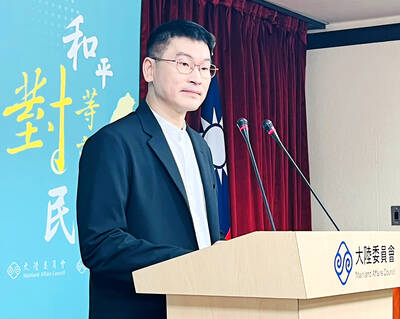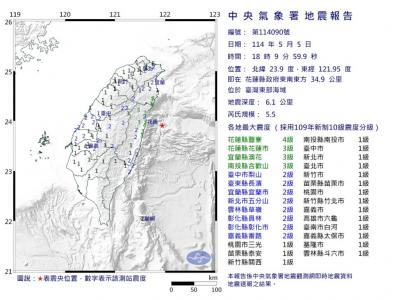Members of the Presidential Office’s Indigenous Historical Justice and Transitional Justice Committee yesterday failed to reach a consensus on controversial guidelines on the delineation of traditional Aboriginal territories, with some calling for its suspension and others supporting its implementation.
Yesterday’s meeting was the first of its kind since the office announced the committee was to be established in August last year. Committee members are scheduled to meet every three months.
The committee consists of 29 members, including the convener — President Tsai Ing-wen (蔡英文) — two deputy conveners, representatives from the 16 officially recognized Aboriginal groups, a Pingpu representative, representatives of government agencies and civic groups, as well as experts and academics.
The Pingpu, also known as plains Aborigines, are assimilated Aborigines who once inhabited the plains from Keelung to Pingtung before Han migrants from China and colonial powers arrived in Taiwan.
Tsai said in her opening speech that while there have been complaints that the committee is not working quickly or effectively enough, committee members must not feel discouraged because transitional justice is a social project that requires long-term efforts.
“Today we took an important step,” Tsai said, adding that the committee’s goals are to ascertain historical truth, promote social communication, put forward appropriate policy suggestions and steer the nation toward reconciliation.
The president said the committee must solemnly exchange opinions on two major issues concerning Aborigines — the delineation of traditional Aboriginal territories, and the official name and status of the Pingpu people.
She said as Aboriginal transitional justice pertains to a complex past and present perception gaps; it requires dialogue and the collective wisdom of the committee members to help assuage historical wounds and achieve social reconciliation.
The guidelines, announced by the Council of Indigenous Peoples last month, have been a magnet for controversy because they exclude all private land.
Some Aborigines have called for the inclusion of private land to grant Aboriginal communities veto power over large-scale development projects, while others have been camping outside the Presidential Office Building in Taipei for nearly a month to protest against the guidelines.
At a post-meeting news conference, deputy convener Pasuya Poiconu (浦忠成) said that 17 committee members expressed their opinions on the delineation guidelines.
“Four of them called for its suspension, while nine said they should be implemented in stages and discussions be held about the delineation of private land. The other four members voiced their concerns about the guidelines,” Pasuya Poiconu said.
Deputy convener Walis Perin said as the proposed guidelines have been sent to the legislature for review, the committee would refer the members’ opinions on the matter to legislators for their reference.
After listening to members’ opinions, Pasuya Poiconu said Tsai said that it is the government’s obligation to lead the public in respecting and understanding the concept of Aborigines’ traditional territories, which does not concern actual land ownership, and is different from the idea of public and private land as defined by current laws.
Tsai also expressed her belief that the committee’s efforts would improve society’s understanding of the history of Aboriginal land rights and result in a better solution to the dilemma of the delineation of Aboriginal lands.

An essay competition jointly organized by a local writing society and a publisher affiliated with the Chinese Communist Party (CCP) might have contravened the Act Governing Relations Between the People of the Taiwan Area and the Mainland Area (臺灣地區與大陸地區人民關係條例), the Mainland Affairs Council (MAC) said on Thursday. “In this case, the partner organization is clearly an agency under the CCP’s Fujian Provincial Committee,” MAC Deputy Minister and spokesperson Liang Wen-chieh (梁文傑) said at a news briefing in Taipei. “It also involves bringing Taiwanese students to China with all-expenses-paid arrangements to attend award ceremonies and camps,” Liang said. Those two “characteristics” are typically sufficient

A magnitude 5.9 earthquake that struck about 33km off the coast of Hualien City was the "main shock" in a series of quakes in the area, with aftershocks expected over the next three days, the Central Weather Administration (CWA) said yesterday. Prior to the magnitude 5.9 quake shaking most of Taiwan at 6:53pm yesterday, six other earthquakes stronger than a magnitude of 4, starting with a magnitude 5.5 quake at 6:09pm, occurred in the area. CWA Seismological Center Director Wu Chien-fu (吳健富) confirmed that the quakes were all part of the same series and that the magnitude 5.5 temblor was

The brilliant blue waters, thick foliage and bucolic atmosphere on this seemingly idyllic archipelago deep in the Pacific Ocean belie the key role it now plays in a titanic geopolitical struggle. Palau is again on the front line as China, and the US and its allies prepare their forces in an intensifying contest for control over the Asia-Pacific region. The democratic nation of just 17,000 people hosts US-controlled airstrips and soon-to-be-completed radar installations that the US military describes as “critical” to monitoring vast swathes of water and airspace. It is also a key piece of the second island chain, a string of

The Central Weather Administration has issued a heat alert for southeastern Taiwan, warning of temperatures as high as 36°C today, while alerting some coastal areas of strong winds later in the day. Kaohsiung’s Neimen District (內門) and Pingtung County’s Neipu Township (內埔) are under an orange heat alert, which warns of temperatures as high as 36°C for three consecutive days, the CWA said, citing southwest winds. The heat would also extend to Tainan’s Nansi (楠西) and Yujing (玉井) districts, as well as Pingtung’s Gaoshu (高樹), Yanpu (鹽埔) and Majia (瑪家) townships, it said, forecasting highs of up to 36°C in those areas